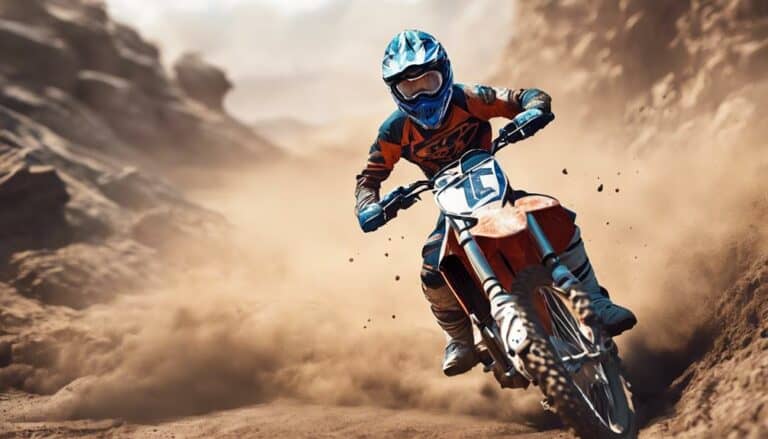Did you know that mastering the art of riding a dirt bike goes beyond just knowing its parts?
Understanding how to maneuver the bike effectively requires a combination of skill, coordination, and practice.
As you navigate through different terrains and scenarios, learning the proper techniques will not only enhance your riding abilities but also guarantee your safety on the trails.
So, are you ready to take your dirt biking skills to the next level by focusing on how to ride, not just the parts of the bike?
Key Takeaways
- Focus on mastering riding techniques over bike parts for improved performance.
- Emphasize balanced stance, braking, acceleration, and turning skills for riding success.
- Practice terrain adaptation for better control and confidence in various riding conditions.
- Prioritize learning how to ride effectively through technique refinement rather than focusing solely on bike components.
Basic Riding Position
To ride a dirt bike effectively, maintain a balanced stance by gripping the tank with your knees and keeping your elbows slightly bent. This position allows you to control the bike better, especially when moving through rough terrain. By positioning your body weight a little bit towards the front of the bike, you enhance your control and handling, making it easier to maneuver through obstacles with precision.
Remember to keep your head up and look ahead on the trail; this enables you to anticipate any upcoming turns or challenges. Relax your grip on the handlebars to facilitate smoother steering and overall riding experience. Additionally, practicing proper foot placement on the foot pegs is essential for maintaining stability and control while riding.
Essential Braking Techniques
When braking on a dirt bike, it's essential to use both the front and rear brakes simultaneously for the best stopping power. Achieving braking balance is vital to prevent skidding and maintain control. Start by applying the brakes gradually to avoid locking up the wheels and losing traction. Remember to use more of the rear brake than the front brake to prevent the front wheel from locking and causing a potential crash. By practicing brake modulation, you can control your speed effectively and improve traction control.
In emergency maneuvers, understanding how to distribute braking force between the front and rear brakes can make a significant difference in stopping power. Safe and efficient stops also involve adjusting your braking technique to match the terrain you're riding on. This adjustment helps prevent skidding and enhances skid prevention, ensuring a smoother and safer ride. Regularly practicing emergency braking in a safe environment can enhance your reaction time and muscle memory, making you more adept at handling unexpected situations. Mastering these essential braking techniques won't only improve your overall riding experience but also keep you safe on the trails.
Mastering Acceleration Control
Master your dirt bike riding skills by honing your control over acceleration, guaranteeing a smooth and controlled riding experience. When it comes to mastering acceleration control, remember these essential tips:
- Throttle Management: Gradually increase throttle to accelerate smoothly, avoiding sudden jerks that can destabilize your ride.
- Speed Control: Practice controlling acceleration in a straight line before taking on turns or obstacles to get a feel for managing your speed effectively.
- Acceleration Tips: Use lower gears for smoother acceleration, giving you better control over your speed as you navigate different terrains.
- Body Positioning: Maintain a balanced body position to handle changes in acceleration with ease, keeping you stable and in control.
- Terrain Awareness: Be mindful of the terrain you're riding on, as it can affect your acceleration. Adjust your technique based on the terrain to guarantee a safe and enjoyable ride.
Navigating Turns With Ease
When tackling turns on your dirt bike, leaning the bike and your body is important for maintaining balance and control. As you approach a turn, focus on your vision and anticipate the path ahead. Look towards the exit of the turn to adjust your speed accordingly.
Use countersteering by applying gentle pressure on the inside handlebar to steer smoothly through the turn. Your body positioning plays a critical role in shifting weight and helping the bike lean effectively into the turn.
By practicing handling turns at various speeds and angles, you can enhance your skills and boost your confidence. Remember, the key elements for mastering turns are vision, anticipation, lean, balance, and proper body positioning.
With these techniques in mind, you can maneuver through turns with ease, feeling the thrill of controlling your dirt bike through each twist and curve. Keep practicing and enjoy the liberation that comes with mastering the art of handling turns on your dirt bike.
Riding on Different Terrain Types
As you tackle various terrains on your dirt bike, adjusting your riding technique to match the terrain type is essential for maintaining control and maximizing performance. Here are some tips to help you navigate different terrain types effectively:
- Tire pressure adjustment, throttle control: Lower tire pressure is pivotal for better traction and control when riding on sand. Smooth throttle control is vital to prevent wheel spin on muddy terrain.
- Footpeg stance, balance techniques: Standing on the footpegs when riding on rocky terrain helps improve balance and shock absorption.
- Stance adjustment, control methods: For loose gravel or dirt, adopt a wider stance and lean back slightly to maintain control and stability.
- Caution on hard surfaces: When riding on pavement or hard surfaces, be cautious with cornering and braking due to reduced traction.
Conclusion
Now that you've mastered the basics of riding a dirt bike, you're ready to take on any terrain with confidence. Remember, practice makes perfect, so keep honing your skills and pushing your limits.
Just like a skilled musician perfecting their craft, you too can become a master of the dirt bike. So gear up, hit the trails, and show the world what you're made of.

